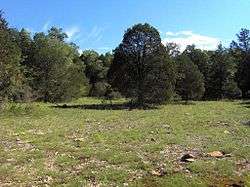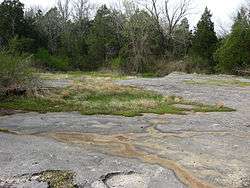Cedar glade


A cedar glade is a habitat type unique to the central eastern United States. Cedar glades occur where limestone bedrock occurs near or at the surface. The glade areas proper have very shallow soil or exposed bedrock in some areas. Because of the shallow soil and the extreme conditions created by it, trees are unable to grow in the glades. This creates a habitat more similar to the prairies hundreds of miles to the west than to the surrounding forests.
Flora of the cedar glades
The "cedar" in the name comes from the abundance of eastern redcedar (Juniperus virginiana) that occurs on the margins of the glades or in cracks in the bedrock where the roots can gain a foothold. Cedar glade vegetation is more typical of a desert habitat than a grassland, being dominated by small spring annuals with occasional geophytic or succulent perennials. Cedar glades are often surrounded by a prairie-like border which may have been historically more extensive before fire suppression and the extinction of megafauna. Many of the characteristic plants that grow in the cedar glades are endemics that occur nowhere else, or disjunct populations of plants that are widespread in the prairies of the central U.S. There are several rare species that are endemic to the cedar glades, including the Tennessee coneflower (Echinacea tennesseensis), Pyne's ground plum (Astragalus bibullatus), leafy prairie clover (Dalea foliosa), lyrate bladderpod (Paysonia lyrata), Nashville breadroot (Pediomelum subacaule), and glade violet (Viola egglestonii).
Threats to the cedar glades
The central basin (or Nashville Basin) of Tennessee is one of the largest areas containing cedar glades. Because of the rapid growth of metropolitan Nashville and the surrounding cities of Murfreesboro and Lebanon, many of the cedar glades have been destroyed by development. The State of Tennessee and the Nature Conservancy have established a number of parks and preserves to protect important plant populations. Cedars of Lebanon State Park in Wilson County and Long Hunter State Park in Davidson County both protect substantial cedar glade ecosystems.
External links
- Center for Cedar Glade Studies at Middle Tennessee State University
- Common and Endemic Herbaceous Plants of Cedar Glades